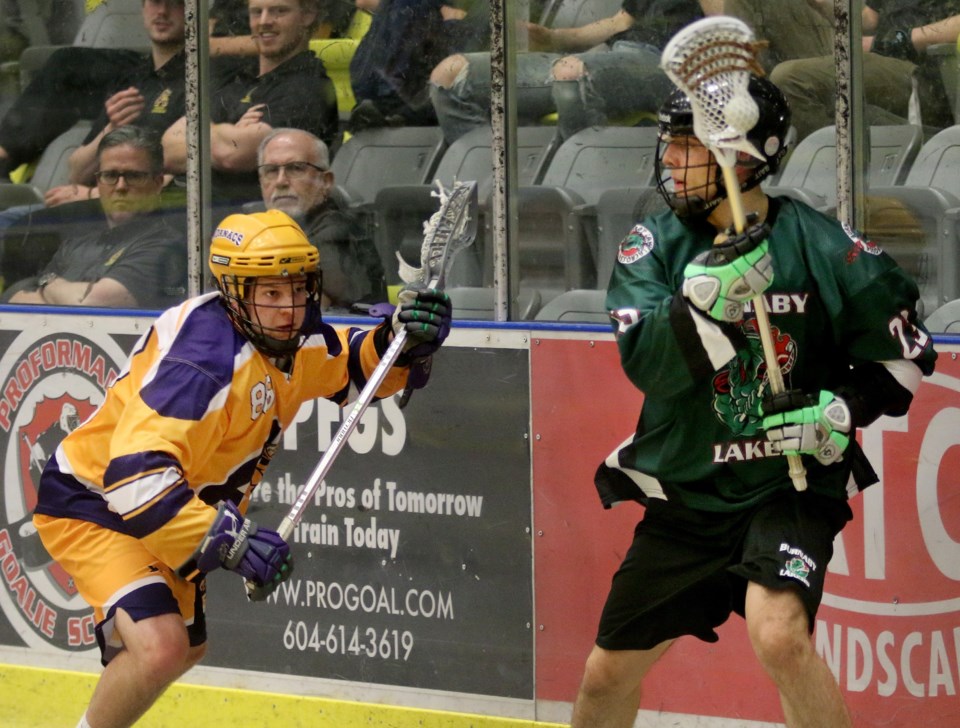The Burnaby junior Lakers are eager to embrace the new reality in the B.C. junior landscape, with a goal to make inroads to join the more competitive clubs.
It may take time, but Lakers head coach Jason Dallavalle believes the new alignment, which turned the three-year cycle into a five-year program, can offer bigger opportunites for teams like his.
Right now, the forecast is still for the same powerhouse clubs to rule the roost, but Burnaby, if it plays the new five-year system to its advantage, should be able to climb the charts, he said.
“Let’s be honest, Coquitlam and New West will be up there again; Victoria, Langley will all be up there and (will have) to release good players that can crack a lot of teams rosters,” said Dallavalle of the upcoming inaugural season of the five-year junior program in B.C. “It’s a matter of convincing them to come over and help build our association and go from there.”
When the provincial lacrosse governors voted to eliminate the intermediate division and copy what has been the system in places elsewhere in Canada, it created not only a five-year junior A circuit, but also a two-tier junior B development program that will move graduating midget players up the ladder faster. It could also create a wave -- perhaps small, but a wave still -- of free agent action previously unseen since the junior A league implemented a midget draft.
Any player coming out of midget who doesn’t make his home junior A club can offer their services to a rival junior A team. They can also head to the junior B tier 1 team with their home club, and would have to follow that route if no junior A team has a spot for them.
But if their goal is to play junior A immediately and they can cut the mustard, Burnaby is open to providing a fit, said Dallavalle.
The Lakers, who began dryland training last month and moved into Burnaby Lake Arena last week, have continually hit a glass ceiling when it comes to cracking the top-four of the circuit.
Last year, the squad finished sixth at 4-15-1-1, but a disappointing 15 points back of a playoff spot.
It’s a considerable hurdle in an eight-team league.
Dallavalle doesn’t expect the changes to produce benefits overnight, but along with wise drafting and developing of local talent, it could bring about the necessary changes to get within the playoff picture.
“It’s one of those things where over time the (new) five-year program will benefit all teams, but now it’s how quickly you can learn best to work with your three rosters and develop players to their top potential and get them into that junior A program,” said Dallavalle as he prepared to beef up indoor practices in the coming week. “Here in B.C. if a player gets cut from junior A he can drive 20 minutes to four other associations; in Ontario, if you get cut from a junior A team you have to drive two-plus hours to get to another junior A program so they just stay and play junior B. It’s a bit different beast over here but we’re all in the same boat.”
He says a handful of midget graduates are knocking at the door to play with the Lakers. Two prospects – Burnaby forward Milos Sukunda and Surrey native and 2018 midget draft pick Nick Dos Santos – are looking like good bets to break camp with Burnaby's junior A team.
The B.C. junior A season starts up for real in just over one month, with Burnaby hosting Victoria on May 6. But with 15 eligible returnees away at college until late May, the window for players to impress and latch onto a firm role is there.
“The mindset we want to set out for these players coming up from midget, the 16 and 17 year olds, is we want players who want to play at the highest level, regardless what age you are and where you are from. We want you pushing to make that junior A roster,” he said.
Both Dos Santos and Sukunda demonstrate that kind of desire, Dallavalle added.
“You can usually tell when a player has that ‘It’ factor. Milos plays elite hockey so he comes in and has that presence, he’s an elite athlete. Nick’s IQ on the floor is something you don’t see from your average 16 years olds playing lacrosse,” he said.
Along with general manager Brad Parker, the coaching staff will be paying close attention to players and their roles, both in green-and-white jerseys and the other side. The core leaders for the Lakers this year are expected to be captain Patrick Shoemay, a six-foot-four sophomore at RIT, and sniper Dylan Kaminski, who attends Staten Island’s Wagner College. Netminder Elijiah Uema-Martin is back for a second season after facing a league-high 829 shots – with the next busiest goalie at 659 shots.
Although no pre-season prognosticators will be putting the Lakers in the playoff picture just yet, the hope is this year’s model will lay the groundwork for such a breakthrough in the coming years. And if they play meaningful games in June, all the better. The good energy that comes at training camp, along with the new changes to the league, has created real optimism, said Dallavalle.
“I think if asked I’d say our transition game will be our best (part and) our main strength this year. If you look at the top teams in the league and you’d see the transition game was their strengths as well,” he noted. “We want to win those battles. I felt last year when we were five-on-five and stayed out of the penalty box, we played with most teams for most of the game.”



